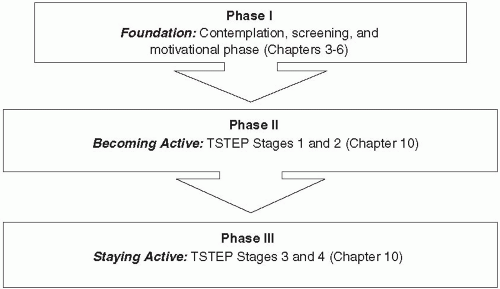INTRODUCTION
In the previous three chapters, we outlined the general principles of exercise prescription, enabling you to design a personalized exercise program for your patient. In this chapter, we use many of those principles to provide you with a specific program that your patients may want to follow in order to either begin exercising and then progress to the ACSM/AHA/HHS-recommended levels, or to advance beyond the minimum recommendations. As with many aspects of this book, we are leaving the choice up to you. It may well be the case that some of your patients will respond better to a specific program such as the ones presented in this chapter, while others will benefit more from a personalized program designed based on the principles and parameters discussed in
Chapters 8 and
9. We can use the same flow diagram presented in
Figure 10.1 to illustrate your patients’ potential progression as they transform their lifestyle from sedentary to active.
Whether you are using the principles-and-parameters approach to exercise prescription (
Chapters 8 and
9) or the specific-prescription approach presented in this chapter, it is important that you review the basic concepts of exercise prescription, as presented in
Chapter 7. If you are working with a patient who is at the stage of maintaining or exceeding the ACSM/AHA/ HHS recommendations it will also be important to review the general information in
Chapter 9, covering topics such as hydration and overtraining, even if you are using the approach presented in this chapter.
The specific training program that we will focus on in this chapter is called The Scheduled Training Exercise Program, or TSTEP. It was designed by Dr. Steven Jonas and has been in use for some years now (
1,
2,
3,
4). The training precepts on which it is based were established some time ago by the worldrenowned middle-distance running coach from the University of Oregon, Bill Bowerman (
5). Adapted from Coach Bowerman’s famous “Ten Principles,”
Table 10.1 highlights the seven key principles for TSTEP.
In this approach you and your patient can pick and choose among the various training schedules provided, depending on the patient’s current fitness
level, her goals, and other considerations. Please note that while the advice and counsel offered in this chapter is aimed primarily at patients who are engaged in leisure-time scheduled exercise, there is plenty of information that will be helpful for those patients following the lifestyle exercise route as well.
TSTEP is designed for use by leisure-time scheduled regular exercisers at any level (up to race training), from at-scratch beginner to experienced sportsperson, who are choosing this mode of regular exercise. For the beginner, it provides an easy, gradual entry into the world of regular exercise that, in terms of graduated time and effort, is as painless as possible (see
Table 10.2). The Program in
Table 10.3 is designed to get your patient to the ACSM/AHA/HHS
weekly-minimum recommendation for regular exercise of moderate intensity. For the experienced regular exerciser, it provides a comfortable, easy-to-maintain program that will keep him in shape without overdoing it (see
Table 10.4).
The overall Program is rigorous in its requirements for consistency and regularity. Nevertheless, it maintains a degree of internal flexibility. Within it, one can move around from high-volume weeks to lower volume ones, depending on other needs and fitness level. However, before getting to those details, let’s go over once again getting started on the road to becoming and being a regular exerciser, since how your patient goes about that is critical to success. Along with very careful, self-developed goal-setting, getting started right is an absolutely critical part of the whole enterprise. As we have said before and will say again, the hard part of regular exercise is the regular, not the exercise. Therefore, the focus in getting active should be first on the regular, not the exercise. Whether one is using the leisure-time scheduled or the lifestyle exercise approach, your first concentration should be to help your patient find the time and make the time that will be set aside for exercise in their life on a regular basis.
For those using the lifestyle exercise approach, that could be determining to climb the stairs part or all the way to the office, at first twice a week, but on
given days; similarly, parking at the far end of the parking lot, at first twice a week, on given days. The idea is to first get used to the pattern. Then, one can start expanding it. Similarly, with leisure-time scheduled exercise, for most people starting from scratch, the first step should be just getting out there and walking, up and down or around the block, for ten minutes or so, three times a week, for a couple of weeks. That’s just plain walking at their regular pace. Not fast, no sweat, no hard breathing. The critical element is to do it on a schedule, like Monday-Wednesday-Friday, or Tuesday-Thursday-Saturday, or Wednesday-Saturday-Sunday, at a given time each time.








